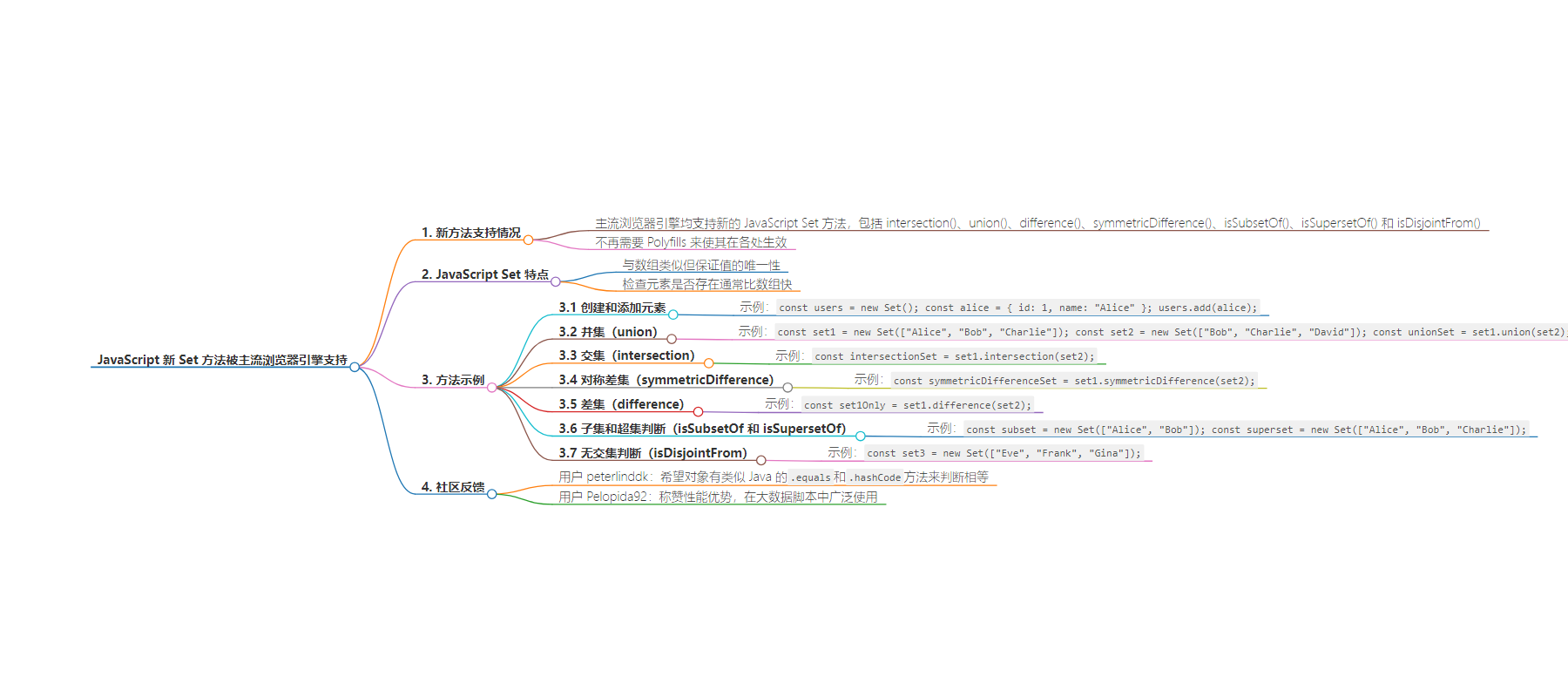包阅导读总结
1. `JavaScript Set 、浏览器引擎 、方法 、性能 、集合操作`
2. 随着 Firefox 127 的发布,所有主流浏览器引擎支持新的 JavaScript Set 方法。这些方法包括交集、并集等,提供了便捷的集合操作方式,简化开发并提升性能,社区对此反应积极。
3.
– JavaScript Set 新方法得到全主流浏览器引擎支持
– 包括 intersection()、union() 等多种方法
– 无需 polyfills 即可工作
– JavaScript Sets 特点与优势
– 保证值唯一性,类似数组但有区别
– 元素存在检查通常比数组快
– 方法示例与用途
– union() 用于合并集合
– intersection() 找共同元素
– symmetricDifference() 找独有元素
– difference() 做元素减法
– isSubsetOf() 和 isSupersetOf() 判断集合关系
– isDisjointFrom() 检查有无共同元素
– 社区积极反馈
– 如用户称赞其用途扩展和性能优势
思维导图:
文章来源:infoq.com
作者:Agazi Mekonnen
发布时间:2024/7/26 0:00
语言:英文
总字数:598字
预计阅读时间:3分钟
评分:85分
标签:JavaScript,Set 方法,浏览器开发,性能优化,数据结构
以下为原文内容
本内容来源于用户推荐转载,旨在分享知识与观点,如有侵权请联系删除 联系邮箱 media@ilingban.com
With the release of Firefox 127, allmajor browser engines now support thenew JavaScript Set methods, including intersection(), union(), difference(), symmetricDifference(), isSubsetOf(), isSupersetOf(), and isDisjointFrom(). Polyfills are no longer required to make them work everywhere. These additions provide convenient, built-in ways to manipulate and compare collections aiming to simplify development and enahnce performance.
JavaScript Sets function similarly to Arrays but guarantees the uniqueness of each value. This automatic removal of duplicates makes Sets perfect for creating unique collections. For instance, here’s a simple example of creating and adding elements to a Set:
const users = new Set();const alice = { id: 1, name: "Alice" };users.add(alice);users.forEach(user => { console.log(user) }); Sets are also typically faster than Arrays for checking if an element exists, making them useful for performance-sensitive applications.
The union() method returns a new Set containing elements from both the original Set and the given Set. This is useful for combining collections without duplicates:
const set1 = new Set(["Alice", "Bob", "Charlie"]);const set2 = new Set(["Bob", "Charlie", "David"]);const unionSet = set1.union(set2);unionSet.forEach(name => { console.log(name); // Outputs: Alice, Bob, Charlie, David}); The “intersection()” method returns a new Set containing only elements present in both Sets. This is helpful for finding common elements:
const intersectionSet = set1.intersection(set2);intersectionSet.forEach(name => { console.log(name); // Outputs: Bob, Charlie}); The symmetricDifference() method returns a new Set containing elements present in either of the Sets but not in both. This is useful for finding unique elements between two Sets:
const symmetricDifferenceSet = set1.symmetricDifference(set2);symmetricDifferenceSet.forEach(name => { console.log(name); // Outputs: Alice, David}); The difference() method returns a new Set containing elements present in the original Set but not in the given Set. This is useful for subtracting elements:
const set1Only = set1.difference(set2);set1Only.forEach(name => { console.log(name); // Outputs: Alice}); The methods isSubsetOf() and isSupersetOf() return Boolean values based on the relationship between Sets. The “isSubsetOf()” method checks if all elements of a Set are in another Set, while the isSupersetOf() method determines if a Set contains all elements of another Set.
const subset = new Set(["Alice", "Bob"]);const superset = new Set(["Alice", "Bob", "Charlie"]);if (subset.isSubsetOf(superset)) { console.log("subset is a subset of superset"); // This will be printed because all elements in subset are also in superset} else { console.log("subset is not a subset of superset");}if (superset.isSupersetOf(subset)) { console.log("superset is a superset of subset"); // This will be printed because all elements in subset are also in superset} else { console.log("superset is not a superset of subset");} The isDisjointFrom() method checks if two Sets have no common elements:
const set3 = new Set(["Eve", "Frank", "Gina"]);if (set1.isDisjointFrom(set2)) { console.log("Set1 and Set2 are disjoint"); // This will be printed because set1 and set2 have no common elements} else { console.log("Set1 and Set2 are not disjoint");}if (set1.isDisjointFrom(set3)) { console.log("Set1 and Set3 are disjoint");} else { console.log("Set1 and Set3 are not disjoint"); // This will be printed because set1 and set3 have a common element "Charlie"} The community has responded positively to these new methods. In aReddit thread, user peterlinddk said:
“Excellent – finally we can use Set for more than a ‘duplicate-detector’. I only wish that there were some way for objects to be ‘equal’ without them having to be the exact same instance. Kind of like Java’s .equals and .hashCode methods.”
Another user, Pelopida92, praised the performance benefits, stating:
“Sets are awesome. I used them extensively for some big-data scripts, as they have way better performance than arrays and are very easy to use and convenient.”
